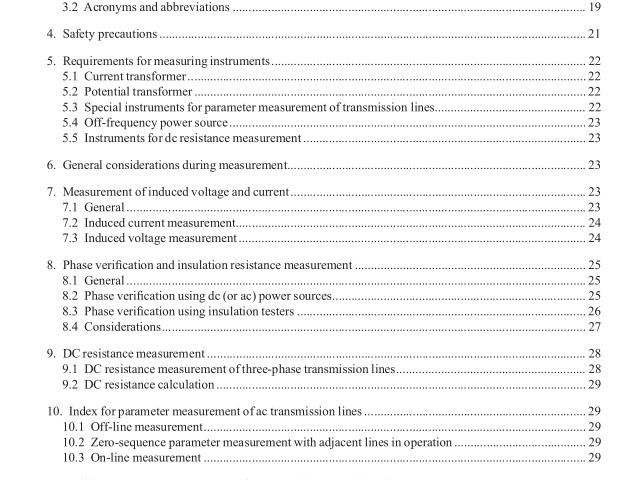IEEE 1870-2019 pdf download.IEEE Guide for the Parameter Measurement of AC Transmission Lines
This guide will prov ide testing methods for impedance measurement of ac transmission lines and calculating methods for the resistance, inductance, and capacitance (RLC) distribution parameters of the tested line. It will also provide testing and calculating methods to obtain mutual inductance and coupling capacitance between double circuit lines on the same tower. This guide will outline the measuring instruments and the safety of the measurement. In addition, it will include test procedures to obtain the open-circuit and short- circuit impedances of the tested line as well as the formulas to get the distributed parameters from impedance measurements.
1.2 Purpose The accurate parameter of the power transmission line is the basis of precise power flow calculations, stability analysis, protective settings, and line fault location. Therefore, it is necessary to develop a unifomm guide to provide technical guidance for the accurate parameter measurement of ac transmission lines.
1.3 Background To understand the importance of measuring electrical parameters, in particular, the short-circuit, positive- sequence impedance Z and zero-sequence impedance Zo, the following case study compares measured and calculated values for the positive-sequence impedance Z and zero-sequence impedance Z0 of 40 power lines with different configurations (power cables, overhead lines and mixed lines consisting of both, power cables, and overhead lines). In Figure 1, the deviation between calculated and measured values for R and especially X of Z are small relative to the ones of Zop.
This is because Z can be accurately calculated by means of the geometry and the material of the conductors. However, for the calculation of Zo the properties of the soil return path shall be known, such as soil resistivity in different soil layers and other parallel buried conductors such as pipes and other grounded elements in residential or industrial areas. All of these properties are unknown and therefore make the calculation inaccurate in contrast to the measurement, which reflects all present properties of the soil return path and therefore provides true values for Zy.
lnaccurate zero-sequence impedance strongly affects zone reaches and accuracy of impedance-based fault location of distance protection relays in the event of a single line to ground fault. The example described here is taken from a measurement on an overhead distribution line with a length of 7 km. Table 1 compares the measured and the calculated values for Z and Zg
The values for Z only deviate negligibly from each other, whereas the deviation for Z0 is significantly high. With respect to this example, the actual zone reach for all phase-to phase and all phase-to-ground faults is determined and shown in the chart of Figure 2 (grading factor is 90%, which means the zone of zone 1 is supposed to be 90% of the line length).
As expected, the actual zone reach for phasc-to-phase faults is close to 90%. This example also considers the measurement of the line ‘s asymmetrical parameters and, therefore, reflects the small deviations in the reaches among the three different phase-to-phase faults. For phase-to- ground faults, however, the reaches are beyond 120%, which might make the relay overreaching and not operating selectively. Using the actual values for Z and Z, which are derived from the measurement, would correct the actual reach to 90% and avoid unselective performance of the relay.
In regard to the accuracy of the impedance-based fault locator, the displayed fault location for a faultat 7 km is determined accurately for phase-to-phase faults. Phase-to-ground faults are displayed much closer to the relay as they actully are, as shown in the chart of Figure 3. Using the actual values for Z and Zn would locate faults much more accurately.IEEE 1870 pdf download.IEEE 1870-2019 pdf download
IEEE 1870-2019 pdf download

Leave a Reply